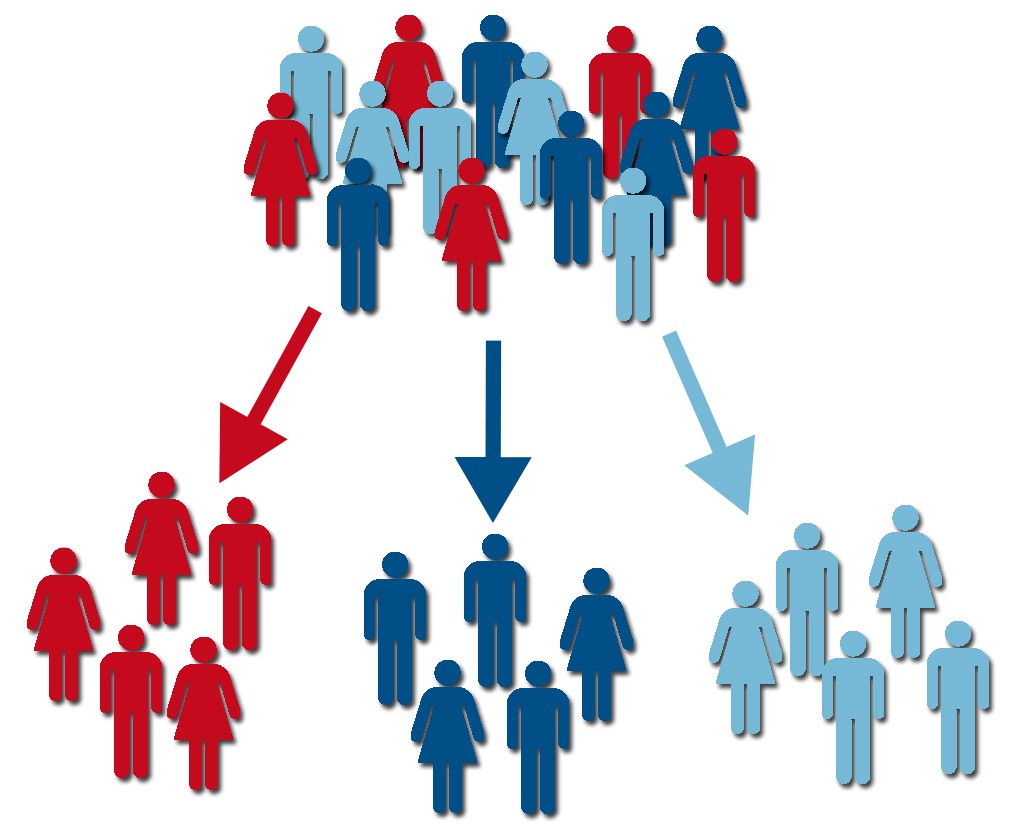What is Market Segmentation
Simply defined, market segmentation is dividing a target market into categories based on similar characteristics like needs, age, location, consumer behavior, gender, income, etc., to formulate sale strategies that uniquely appeal to each group and ultimately increase company sales.
It is a form of market research whereby marketers classify potential buyers of their product (or products) into subgroups based on common attributes to understand each group’s needs and identify how to successfully direct marketing efforts to the right consumer.
Properly carried out, market segmentation gives marketers the chance to identify potential clients, understand their specific product needs/wants, and how to meet them.
Take, for instance, a brand that sells high-end skin products and segments its target audience into;
Men between the ages of 25 – 40, receiving a minimum monthly income of $1000.
Women between the ages of 20 – 45 receiving a minimum monthly income of $1500.
Working with this data, this brand can determine what advertisement form, product, and sale strategy would attract and deliver its products to the different categories of prospective buyers.
At the same time, such a brand can maximize its marketing cost, minimize its production expenses, reduce the risk of loss and increase its profits.
Importance of Market Segmentation

Market segmentation gives a brand the data needed to understand the various groups that make up its entire target audience and what sale strategies will be effective in helping each group connect with and appreciate the total value of the product or service in question.
Without this information or data, marketing will be based on trial and error as companies would not know who their potential customers are or what they need.
Benefits of Market Segmentation

There are plenty of benefits of segmenting your market. They include:
Identifying your prospective customer
The marketplace contains billions of individuals with distinct needs and preferences, and a product/service cannot meet the needs of all. Hence, market segmentation allows companies/brands to spot and focus on individuals with problems solved by their product/service.
Formulating effective sale strategies
Upon understanding your potential customers, all that is left is creating marketing strategies that draw them in. With market segmentation allowing for the grouping of the target audience into sub-markets based on collected data, a marketing team can effortlessly draw up personalized sale strategies that address the needs and desires of each sub-market.
Take for instance, a Canadian company that is into cooking wares and has invested thousands of dollars into social media adverts. Finding out that sales are low compared to its marketing costs plus other production expenses, the company carries out market research.
In no time, the company’s ideal customers are shown to be middle-aged Canadian men and women who watch TV in the mornings and read food magazines in the evenings.
Armed with this information, the marketing team goes back to its board, groups its prospective clients under the relevant categories, and fashions new sale strategies targeted to appeal to the distinct needs/preferences of the different groups – everyone wins.
Increase in sales and profits
Still using the example of the company that sells cooking wares and has now modified its marketing strategy thanks to market segmentation. Such a company will find that by restructuring and tailoring its marketing strategy, it can say the right things to the right group, connect with ideal customers in a way they can understand, and eventually increase conversion and make more profits.
Hence, rather than waste limited resources by continuously funding an unproductive/unprofitable sales plan, market segmentation helps a company realize the ideal method of efficiently expanding its resources to achieve its marketing goal.
Develop the perfect product/service
Because human needs are changing, brands that want to stay relevant need to manufacture products that attend to the current pain points of their target audience. For our love of examples, let us take another look at a company that owns several fuel stations.
Realizing a drop in gas sales, this company carries out a psychographic market segmentation, which reveals that due to the increase in the cost of gas, many of its potential clients have switched to electric cars, and now there is a need for charging stations.
Equipped with this data, this company invests in erecting charging stations at various locations rather than building fuel stations.
Taking this step will help such a company stay relevant to its target audience, a choice that will prove profitable to it in the long run.
Room for growth and expansion in the right direction
Growth in the right direction is a spill-over effect of market segmentation because it allows companies to know their market current needs and how to solve them.
Such knowledge presents companies with the chance to expand and grow properly.
This is as opposed to deciding to offer a new service, open a new location or manufacture a new product while being unmindful of whether this new addition will meet the present needs of your market audience.
Asides from these listed, other benefits of market segmentation include:
– Customer loyalty to a brand that knows what they want.
– Assists brands in staying focused on potential customers and how to meet their evolving needs
– A brand that understands its customers and what they want will always stand out.
– Good customer service, etc.
Types of Market Segmentation

As we stated earlier, classifying your target audience into various categories can be done by segmenting them based on similar characteristics or attributes.
In line with this, there are five known types of market segmentation or (if you prefer) four ways you can group your target audience.
They include:
– Geographic segmentation; which is based on physical locations
– Demographics segmentation; which is based on variables
– Behavioral segmentation; which is based on everyday actions
– Psychographic segmentation; which is based on psychology and motivations
– Firmographic segmentation; employed by b2bs in identifying target business
Market Segmentation Analysis

Having highlighted the vital role segmenting the target audience plays in marketing, it goes without saying that any brand seeking to enjoy the full benefits of market segmentation must ensure it is properly done from beginning to end.
Such brands need to make sure their pool of potential customers is categorized correctly and that the specific pain points of the various groups are understood perfectly.
This is where market segmentation analysis comes in.
As the phrase suggests, market segmentation analysis means the study of market segments. It refers to the grouping of prospective clients under appropriate submarkets and comprehensive research about the buyer behavior of each group.
As I mentioned earlier, there are five types of segmentation under which a brand can segment its pool of prospective customers.
However, knowing the best type(s) that will yield optimal results for your brand/company will depend on how well you conduct your market segmentation analysis.
That being said, there are five steps to effectively carrying out a market segmentation analysis. These steps include:
Obtain accurate customer data
Understanding your target audience is necessary for categorizing them into appropriate sub-markets.
With technology making things easy, a brand/company can quickly grasp the consumer behavior of their market through online surveys, phone calls, etc.
Note that this step takes a long time compared to the others because of its sensitive nature; carried out hurriedly or haphazardly, a company will procure bad or irrelevant data, which will affect the market grouping and yield poor results.
Extract the appropriate segments and group your market
The next step is to divide the market into subgroups using the client data collected.
The types of market segmentation; geography, behavior, psychography, firmographic, and demography can be a guide when doing this.
However, it is possible to detect naturally existing groups from the data collected. In such a scenario, you can decide to categorize your market under those segments.
Profile the selected segments. Step two and this step run hand-in-hand as successfully grouping your target market will depend on how well you profile the segment extracted from the customer data.
Profiling or describing the submarkets, in this case, means in-depth research and understanding of each group. It refers to giving a detailed description of the characteristics an ideal customer in a particular segment would have.
This will help you understand the distinct needs/pain point of each segment and how to meet it.
Select specific segments. Because most businesses do not have an inexhaustible stash of cash, companies, particularly startups and small businesses, are typically advised to target specific segments that will yield the highest turnover rather than trying to meet the needs of all the groups within the market. This enables such a company to maximize its limited resources while focusing on the right group.
Put it to practice. If all the previous steps listed above are accurately carried out, they will result in an excellent theoretical market segmentation analysis.
A good result but nevertheless meaningless until it implemented, which is where this step comes in – convert the results into marketing plans or strategies that will achieve the desired market goals.
Market segmentation process

As a brand or company new to segmenting your target market, it is normal to experience some little hiccups as you start.
However, to reduce the likelihood of this, here are the primary steps to take when mapping out an ideal market segmentation strategy for your business.
Who is your audience?
As we have been emphasizing from the start, knowing your target audience is vital to the success of any brand/company. Who are those who need your product/service? How will your product/service meet their needs? Why will they patronize you? These questions and more need to be answered when determining your overall market.
Categorize your prospective customers
After knowing your target market, the next step is to pinpoint the groups they fall under.
As I indicated under market segmentation analysis, you can decide to group your prospective customers using the four major types of market segmentation as a guide or group based on a natural segmentation discovered from the consumer data.
In either case, it is necessary to group your consumers based on their common characteristics, attributes, or consumer behavior.
Profile the segments
The next thing is to understand the needs and preferences of each category. What makes the consumers in a group similar to each other? What makes them different from others in another group?
Under this step, consumers placed in a category need to respond similarly to a marketing strategy tailored to that group.
Assess the market potential of the segments
Upon profiling the segments, a brand needs to evaluate each one to find out its market potential; how well it will respond to the brand’s product or service.
Gauging the market segments in this way ensures that a company does not waste time or resources targeting an unprofitable segment.
Brands can gauge the market potential of a sub-market by looking at:
– The number of potential customers in the segment
– The expected profit
– The cost of targeting the segment
– Accessibility to the customers in the segment
– The existing competition
Choose the group you will be focusing on
Rather than attempting to meet the needs of all the segments, it is best to target specific ones whose market performance aligns with set marketing goals and objectives.
Craft the ideal sales plan
Armed with the knowledge of who your ideal client is, their pain points, needs, and desires, creating sales strategies that are relevant and appealing becomes easy for the marketer.
Conduct occasional market reviews
As we stated earlier, human needs are not static. This means that your target audience’s needs can change. Hence, a brand that wants to stay relevant needs to conduct periodical market reviews.
Finally…
A brand that segments its market audience is like someone who knows their destination.
Such a person need not be confused about the means of transport, routes to take, or whether they will arrive in time. So also market segmentation makes it easy to identify those that need your product/service, decipher their pain points, what they want in a product, and how your product can meet those needs, thus meeting set market objectives.
RELATED: 5 Types of Market Segmentation
You love this Article, right? Get more Updates via Adilo’s Twitter Page.
https://d3o1wlpkmt4nt9.cloudfront.net/wp-content/uploads/2018/01/15134054/target-market-2-min.jpg
https://www.startups.com/library/expert-advice/defining-target-market-think-small
https://apptimize.com/wp-content/uploads/2015/03/Segmentation.jpg
https://miro.medium.com/max/1024/1*GuPZRzN0IBLfyDCfn7-7NA.jpeg
https://www.voxco.com/blog/market-segmentation-strategy-a-boon-for-market-research/
https://www.reachmarketing.com/6-simple-steps-to-segmentation/
https://www.freepik.com/premium-vector/target-audience-concept-vector-illustration_7546792.htm













